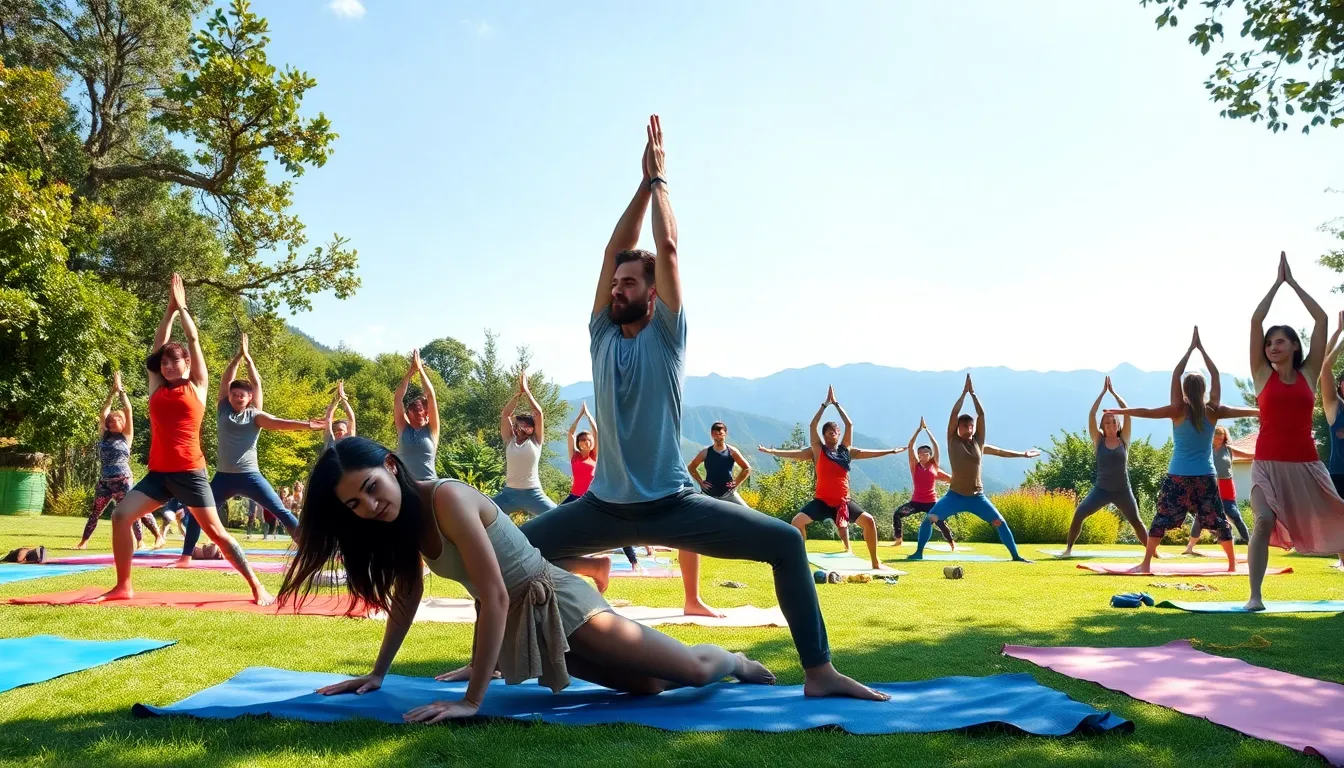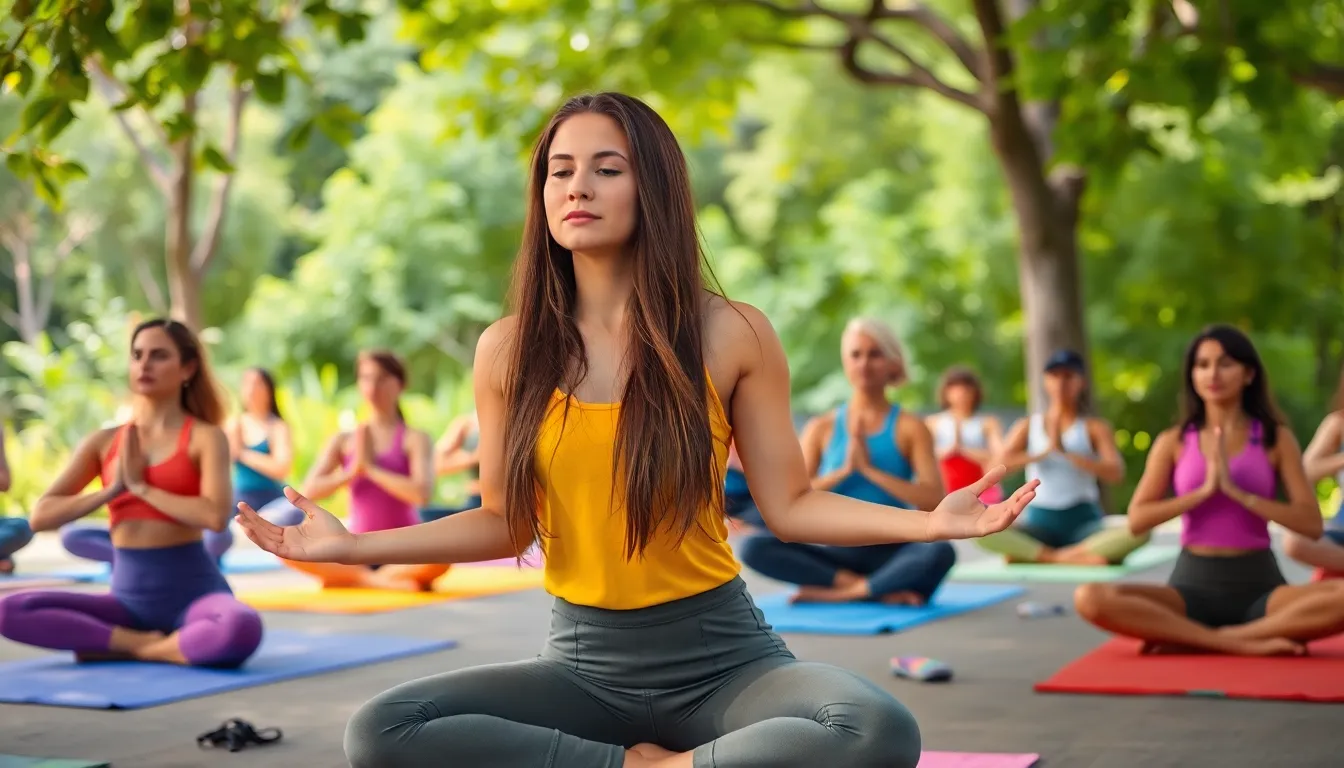In a world where stress levels are higher than a cat on a hot tin roof, yoga practice offers a blissful escape. Imagine bending like a pretzel while your worries melt away—sounds like a dream, right? But it’s not just about striking a pose; it’s about finding balance in both body and mind.
Whether you’re a seasoned yogi or someone who thinks downward dog is a new breed of puppy, there’s something for everyone. This ancient practice combines flexibility, strength, and a sprinkle of zen, making it the perfect antidote to modern chaos. So grab your mat and get ready to discover how yoga can transform not just your body, but your entire outlook on life. After all, who wouldn’t want to be the calm in the storm?
Table of Contents
ToggleBenefits Of Yoga Practice
Yoga offers numerous benefits that extend beyond physical movement and relaxation. Practicing yoga enhances overall well-being for practitioners of all levels.
Physical Health Benefits
Practitioners experience improved flexibility through regular yoga sessions. Increased strength accompanies many poses, promoting better muscular tone. Enhanced balance contributes to greater stability in daily activities. Additionally, yoga supports cardiovascular health by encouraging better circulation. Reduced risk of injury arises from increased body awareness and control.
Mental Health Benefits
Reduction in stress levels often results from mindful breathing techniques in yoga. Enhancing focus and concentration can occur through regular meditation practices. Improved emotional regulation allows individuals to respond rather than react to stressors. Building resilience develops with consistent practice, fostering a sense of calmness. Lastly, practitioners report higher levels of overall happiness and satisfaction in life.
Types Of Yoga Practice

Various types of yoga practice cater to different goals and preferences, making yoga versatile for everyone. Below are some key styles frequently practiced.
Hatha Yoga
Hatha yoga focuses on physical postures and foundational yoga techniques. It typically serves as an introductory practice for beginners, emphasizing alignment and breathing. Practitioners experience slow-paced movements, allowing time to explore poses. Flexibility, strength, and relaxation form the core benefits. Many individuals find Hatha yoga effective for reducing stress and improving overall well-being.
Vinyasa Yoga
Vinyasa yoga involves a series of poses performed in a flowing sequence, synchronizing breath with movement. This style provides an invigorating workout, promoting cardiovascular health and physical endurance. Practitioners enjoy dynamic transitions between poses, which prevent the experience from becoming monotonous. Vinyasa yoga encourages creativity, as each session may vary from one class to another. Enhanced focus and mindfulness are additional benefits of this practice.
Ashtanga Yoga
Ashtanga yoga features a set series of poses performed in a specific order, emphasizing discipline and consistency. Practitioners benefit from building strength, flexibility, and stamina through the rigorous flow. Each session follows a predetermined sequence, allowing participants to track progress over time. The use of breath (ujjayi) is integral, creating an internal heat that aids in detoxification. Ashtanga yoga often cultivates a deeper connection to one’s practice.
Getting Started With Yoga Practice
Yoga practice offers a journey toward improved physical and mental well-being. Starting involves understanding various styles and locating suitable classes.
Choosing The Right Style
Choosing the right style of yoga depends on individual needs and goals. Hatha yoga suits those seeking a gentle introduction with an emphasis on breath and alignment. Vinyasa yoga appeals to practitioners who enjoy dynamic movement and cardiovascular benefits. Ashtanga yoga challenges individuals looking for a structured routine focused on discipline. Restorative yoga provides deep relaxation, ideal for stress relief. Exploring these styles helps individuals identify a practice that resonates with them.
Finding A Class
Finding a yoga class begins with assessing local studios or community centers. Many studios offer beginner sessions, ensuring a welcoming environment for newcomers. Online platforms present options for virtual classes, making participation more accessible. Reading reviews can help gauge the quality of instruction and atmosphere at different venues. Some practitioners prefer one-on-one sessions for personalized guidance, while others thrive in group settings. Engaging with instructors during trial classes can clarify the best fit for one’s practice.
Common Myths About Yoga Practice
Many misconceptions surround yoga practice, which can deter individuals from exploring its benefits.
One prevalent myth suggests that yoga requires exceptional flexibility. In truth, yoga caters to all body types and flexibility levels.
Another common belief posits that yoga is solely for women. While many women practice yoga, men also benefit from its physical and mental advantages.
Some people think yoga is merely a trendy exercise. This view overlooks its deep historical roots and holistic approach to well-being.
A popular assumption claims that yoga is only about physical postures. In reality, yoga integrates mindfulness, breathwork, and meditation, enhancing mental and spiritual health.
Some individuals associate yoga with spiritual beliefs that may not align with their own. Yoga exists as a versatile practice, allowing participants to engage with it in a way that fits their personal values.
Another misunderstanding is that attending yoga classes requires significant financial investment. Many affordable options exist, including community classes and free online sessions, making yoga accessible to everyone.
Some fear that yoga is too strenuous or advanced. Beginner-friendly classes are widely available, making it easy for newcomers to find a comfortable starting point.
Individuals often believe that practicing yoga will produce immediate results. Progress takes time, and regular practice yields gradual improvements in strength, flexibility, and mental clarity.
Addressing these myths encourages broader participation in yoga practice, promoting its benefits for diverse audiences.
Embracing yoga can be a life-changing decision. Its multifaceted benefits extend beyond mere physical fitness to encompass mental clarity and emotional stability. By integrating yoga into daily routines individuals can cultivate a sense of peace and resilience that counters the stresses of modern life.
Whether someone is a seasoned practitioner or just starting out the journey into yoga offers a path to greater self-awareness and holistic wellness. With various styles available there’s a practice suited for everyone. The key lies in exploring options and finding what resonates personally.
Ultimately yoga invites individuals to connect with themselves fostering a transformative experience that nurtures both body and mind.



